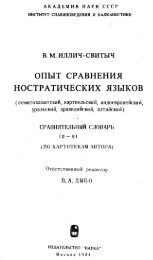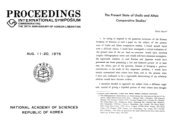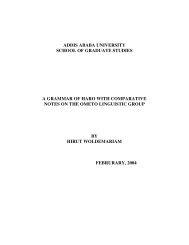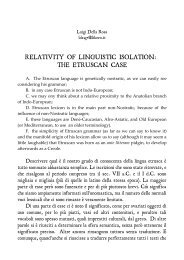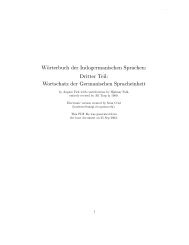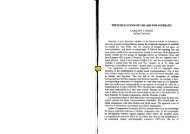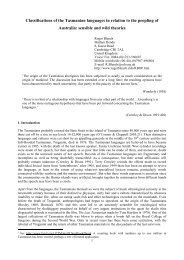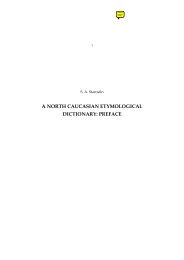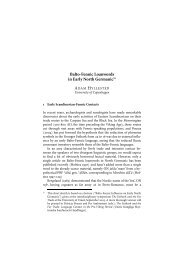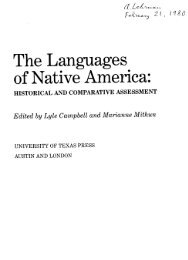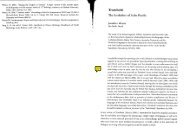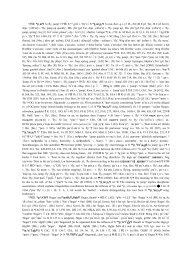The Indo-European Elements in Hurrian
The Indo-European Elements in Hurrian
The Indo-European Elements in Hurrian
Create successful ePaper yourself
Turn your PDF publications into a flip-book with our unique Google optimized e-Paper software.
9. Before Proto-<strong>Indo</strong>-<strong>European</strong> and <strong>Hurrian</strong> 157<br />
earlier deictic elements: (a) *-m-, (b) *-w-, (c) *-t-, and (d) *-s-. <strong>The</strong> relationship of the first<br />
three elements to the personal pronoun stems is obvious: (a) *me-, stem of first person s<strong>in</strong>gular,<br />
used to form the oblique cases; (b) *we-, stem of first person, s<strong>in</strong>gular and plural (later also<br />
dual); and (c) *te-, stem of second person s<strong>in</strong>gular. <strong>The</strong> last element is related to the deictic stem<br />
*so-, which developed <strong>in</strong>to a demonstrative pronoun <strong>in</strong> the daughter languages: ‘this, that’. <strong>The</strong><br />
later second person personal end<strong>in</strong>g *-s- may also have been related to an <strong>in</strong>dependent personal<br />
pronoun stem *si- ‘you’, which no longer existed <strong>in</strong> the later stages of Proto-<strong>Indo</strong>-<strong>European</strong>,<br />
hav<strong>in</strong>g been completely replaced by *tu-/*te-. F<strong>in</strong>ally, the third plural end<strong>in</strong>g *-(e)n is related to<br />
the anaphoric pronoun stem *ne-/*no- found, for example, <strong>in</strong>: Hittite na-aš ‘that’; Armenian na<br />
‘that; he, she, it; him, her’.<br />
In active verbs, the plural was dist<strong>in</strong>guished from the s<strong>in</strong>gular by an <strong>in</strong>traparadigmatic<br />
accent shift (cf. Beekes 1995:234; Clackson 2007:124; Fortson 2004:87; Meillet 1964:241;<br />
Szemerényi 1996:314). In the s<strong>in</strong>gular, the root was accented and had full-grade, while the<br />
end<strong>in</strong>gs had zero-grade. In the plural, the position of the accent was shifted to the end<strong>in</strong>g, with<br />
the result that the root had zero-grade, while the end<strong>in</strong>gs had full-grade. This pattern<strong>in</strong>g has been<br />
most clearly preserved <strong>in</strong> Sanskrit, which is particularly archaic <strong>in</strong> this regard. <strong>The</strong> pattern<strong>in</strong>g<br />
was as follows, us<strong>in</strong>g the verbal root *H÷es- ‘to be’ for illustration:<br />
S<strong>in</strong>gular Plural<br />
1 *H÷és + *me > *H÷és-m *H÷es + *mé > *H÷s-mé<br />
*H÷és + *we > *H÷és-w *H÷es + *wé > *H÷s-wé<br />
2 *H÷és + *te > *H÷és-t *H÷es + *té > *H÷s-té<br />
3 *H÷és + *(H÷)e > *H÷es-Ø *H÷es + *(H÷)é > *H÷s-é<br />
Note: <strong>The</strong>re may have been alternative end<strong>in</strong>gs for the first person.<br />
An important assumption here is that the orig<strong>in</strong>al end<strong>in</strong>g of the third person was *-(H÷)e<br />
— the same end<strong>in</strong>g found <strong>in</strong> the stative verbs. This assumption is based upon the observation<br />
that the form of the third plural is anomalous. Had *ne- been added directly to the root, the<br />
expected form would have been as follows: *H÷es- + *né > *H÷s-né, just like <strong>in</strong> the first and<br />
second persons plural. However, the actual form was *H÷s-én (> *H÷s-én-t-i, after *-t- and *-i<br />
were added [cf. Sanskrit sánti ‘they are’]). This <strong>in</strong>dicates that *ne- was not added directly to the<br />
root but, rather, to *H÷s-é, thus: *H÷s-é + *ne > *H÷s-é-n. Here, the accent was kept on the<br />
end<strong>in</strong>g *-é-, and, consequently, the element *ne had zero-grade. By the way, the same pattern<strong>in</strong>g<br />
may be observed <strong>in</strong> the third plural of stative verbs, where *-ér is to be derived from *-é + *re.<br />
<strong>The</strong> personal end<strong>in</strong>gs of stative verbs are to be analyzed <strong>in</strong> the same way. <strong>The</strong> first<br />
person s<strong>in</strong>gular end<strong>in</strong>g *-Høe is to be seen as an earlier deictic element. <strong>The</strong> same element was<br />
added to the second person s<strong>in</strong>gular end<strong>in</strong>g *-te: *-te + *-Høe > *-tHøe. <strong>The</strong> third person<br />
s<strong>in</strong>gular end<strong>in</strong>g *-e was probably orig<strong>in</strong>ally the deictic element *-(H÷)e. F<strong>in</strong>ally, the third person<br />
plural end<strong>in</strong>g is probably to be derived from an earlier deictic element *re.<br />
Unlike the active verbs, there was no <strong>in</strong>traparadigmatic accent shift <strong>in</strong> the stative verbs.<br />
Here, the accent rema<strong>in</strong>ed on the end<strong>in</strong>g throughout the paradigm:



